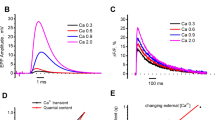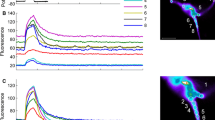Abstract
Calcium (Ca2+) is a key ion involved in transmitter release in chemical synapses. Optical recording of fluorescence changes of Ca2+ indicators is one of the most frequently used methods to measure intracellular Ca2+ dynamics. This technique is based on use of Ca2+-binding fluorescent dyes which change their emission intensity after binding to Ca2+. The most crucial step in this type of experiments is loading of Ca2+ dye. In this paper, we present the method of Ca2+-sensitive dye loading to mammalian nerve endings through the stump of the nerve. We represent Ca2+ transient registered parameters in response to a single motor nerve stimulus. The study of Ca2+ dynamics during high frequency stimulation close to real pattern of synaptic transmission allows us to understand such fundamental process as synaptic plasticity. We describe the results obtained during the registration of Ca2+ transient caused by the rhythmic motor nerve stimulation. Intracellular level of Ca2+ estimated by the amplitude of Ca2+ transient rises with the increase of stimulation frequency. The amplitude of Ca2+ transient decreases after blocking of voltage dependent Ca2+ channels by cadmium. The obtained data showed that detected increase of fluorescence intensity is induced by Ca2+ influx through the voltage-gated Ca2+ channels to the nerve ending during an action potential. This dye-loading method is suitable for registration of presynaptic Ca2+ dynamics under both single nerve stimulus and rhythmic activity.


Similar content being viewed by others
References
Katz, B., & Miledi, R. (1965). The effect of calcium on acetylcholine release from motor nerve terminals. Proc Roy Soc London B Biol Science, 161, 496–503.
Smith, S. J., & Augustine, G. J. (1988). Calcium ions, active zones and synaptic transmitter release. Trends in Neurosciences, 11, 458–464.
Jappy, D., Valiullina, F., Draguhn, A., Rozov, A. (2016). GABABR-dependent long-term depression at hippocampal synapses between CB1-positive interneurons and CA1 pyramidal cells. Frontiers in Cellular Neuroscience, 10, 4. doi:10.3389/fncel.2016.00004.
Neher, E. (1995). The use of fura-2 for estimating Ca buffers and Ca fluxes. Neuropharmacology, 34, 1423–1442.
Khaziev, E. F., Fatikhov, N. F., Samigullin, D. V., Barrett, G. L., Bukharaeva, E. A., Nikolsky, E. E. (2012). Decreased entry of calcium into motor nerve endings upon activation of presynaptic cholinergic receptors. Doklady Biological Sciences, 446, 283–285.
Mintz, I. M., Sabatini, B. L., Regehr, W. G. (1995). Calcium control of transmitter release at a cerebellar synapse. Neuron, 15, 675–688.
Molgó, J., & Mallart, A. (1985). Effects of Anemonia sulcatatoxin II on presynaptic currents and evoked transmitter release at neuromuscular junctions of the mouse. Pflügers Archiv, 405(4), 349–353.
Slutsky, I., Rashkovan, G., Parnas, H., Parnas, I. (2002). Ca2 + -independent feedback inhibition of acetylcholine release in frog neuromuscular junction J. Neuroscience, 22(9), 3426–3433.
Tsien, R. Y. (1989). Fluorescent indicators of ion concentrations. Methods in Cell Biology, 30, 127–156.
Macleod, T. G. (2012). Direct injection of indicators for calcium imaging at the Drosophila larval neuromuscular junction. Cold Spring Harbor Protocols, 2012, 797–801.
Regehr, W. G. (2005). Monitoring presynaptic calcium dynamics with membrane-permeant indicators. In R. Yuste & A. Konnerth (Eds.), Imaging in neuroscience and development: a laboratory manual (pp. 307–314). New York: Cold Spring Harbor Laboratory Press.
Petrov, K., Girard, E., Nikitashina, A., Colasante, C., Bernard, V., Nurullin, L., et al. (2014). Schwann cells sense and control acetylcholine spillover at the neuromuscular junction by α7 nicotinic receptors and butyrylcholinesterase. The Journal of Neuroscience, 34(36), 11870–11873.
Peng, Y. Y., & Zucker, R. S. (1993). Release of LHRH is linearly related to the time integral of presynaptic Ca2+ elevation above a threshold level in bullfrog sympathetic ganglia. Neuron, 10, 465–473.
Macleod, T. G. (2012). Forward-filling of dextran-conjugated indicators for calcium imaging at the drosophila larval neuromuscular junction. Cold Spring Harbor Protocols, 2012, 791–796.
Zhilyakov, N., Khaziev, E., Sudakov, I., Kazakov, A., Aleksandrov, M., Samigullin, D. (2016). Loading mammalian nerve endings with calcium dye through the nerve stump. Inter Res J, 3(45), 12–16.
David, G., & Barrett, E. F. (2003). Mitochondrial Ca2+ uptake prevents desynchronization of quantal release and minimizes depletion during repetitive stimulation of mouse motor nerve terminals. Journal of Physiology, 548(Pt 2), 425–438.
Soga-Sakakibara, S., Kubota, M., Suzuki, S., Akita, T., Narita, K., Kuba, K. (2010). Calcium dependence of the priming, activation and inactivation of ryanodine receptors in frog motor nerve terminals. European Journal of Neuroscience, 32(6), 948–962.
Kazakov, A., Aleksandrov, M., Zhilyakov, N., Khaziev, E., Samigullin, D. (2015). A simple suction electrode for electrical stimulation of biological objects. Inter Res J, 40(9), 13–16.
Vyshedskiy, A., & Lin, J. W. (2000). Presynaptic Ca2+ influx at the inhibitor of the crayfish neuromuscular junction: a photometric study at a high time resolution. Journal of Neurophysiology, 83, 552–562.
Samigullin, D., Fatikhov, N., Khaziev, E., Skorinkin, A., Nikolsky, E., Bukharaeva, E. (2015). Estimation of presynaptic calcium currents and endogenous calcium buffers at the frog neuromuscular junction with two different calcium fluorescent dyes. Frontiers Synaptic Neuroscience, 6, 29. doi:10.3389/fnsyn.2014.00029.
Regehr, W. G., & Atluri, P. P. (1995). Calcium transients in cerebellar granule cell presynaptic terminals. Biophysical Journal, 68, 2156–2170.
Acknowledgments
This work was supported by the Russian Government’s Program for Competitive Growth of Kazan Federal University and a grants from the Russian Foundation for Basic Research (16-04-01051; 16-34-00817; 15-04-02983).
Author information
Authors and Affiliations
Corresponding author
Ethics declarations
The experimental protocol met the requirements of the European Communities Council Directive 86/609/EEC and approved by the Ethical Committee of Kazan Medical University.
Rights and permissions
About this article
Cite this article
Samigullin, D.V., Khaziev, E.F., Zhilyakov, N.V. et al. Calcium Transient Registration in Response to Single Stimulation and During Train of Pulses in Mouse Neuromuscular Junction. BioNanoSci. 7, 162–166 (2017). https://doi.org/10.1007/s12668-016-0318-6
Published:
Issue Date:
DOI: https://doi.org/10.1007/s12668-016-0318-6




